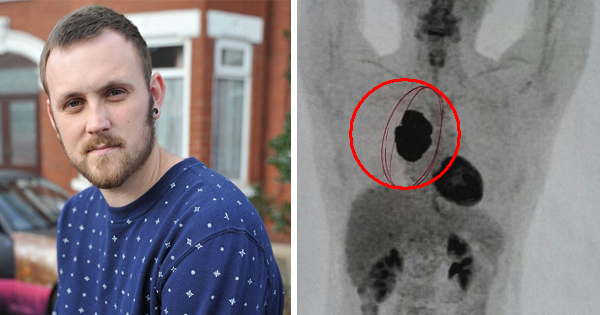Advertisement
When Kye Hodgkins was only 22 years old, he discovered strange lumps growing in his neck. When he went to get them checked out, his doctors diagnosed him with Hodgkin’s lymphoma, a cancer that begins in the lymphatic system (or the immune system) and takes over much of the body’s white blood cells.
His doctors immediately put Eastwood on chemotherapy and radiotherapy, but when a large, cancerous mass in his chest kept failing to respond to treatment, they ran more biopsies.
It was then that they discovered Eastwood had also developed a massive, aggressive tumor in his chest as a result of Hodgkin’s lymphoma.
Eastwood’s form of Hodgkin’s lymphoma was more precisely diagnosed as being diffuse non-Hodgkin’s lymphoma. One of 20 patients with this form of Hodgkin’s lymphoma will develop a primary mediastinal B-cell lymphoma (PMBL). The PMBL is a tumor that develops in the chest and poses great health risks to the patient because it physically crowds the lungs and esophagus, and can press on the vein that carries blood back to the heart.
The doctors had no other way of treating Eastwood, save from having him undergo even more intensive chemotherapy treatments and beginning autologous stem cell transplants in hopes of boosting his immune system during this time.
In spite of the doctors’ best efforts, Eastwood’s condition kept declining. At this point, the medical system in the UK could offer him no other treatment methods, so he turned to alternative methods of treatment elsewhere, around the country.
Nothing helped. Over time, even these alternative treatments had to be stopped because his cancer had spread to far to be treated – by doctors in the UK.
One of Eastwood’s family members advised him to seek professional help in America, where the medical standards for clinical and trial treatments were different than those in the UK.
Eastwood and his family fundraised about $40,000 to send him to the States for consultation and treatment. A research hospital in Maryland accepted Eastwood into their program and decided to have him undergo an allogeneic – rather than an autologous – stem cell transplant.
He would receive stem cells from his sister rather than himself. This would, doctors hoped, give Eastwood a “new” immune system that could attack his tumors with fresh strength.
And indeed, over the course of the next year, Eastwood and his family watched his tumors disappear. The day Eastwood received the news that he had beat cancer, his mother sobbed. “I started to cry and I just couldn’t stop. … I am the happiest mother in the world right now,” she recalls.
Eastwood knows he will have to return to the hospital for routine checkups into the future, but he now finally has fresh hope when he thinks about the rest of his life.
You can see the progression of Eastwood’s scans here:




